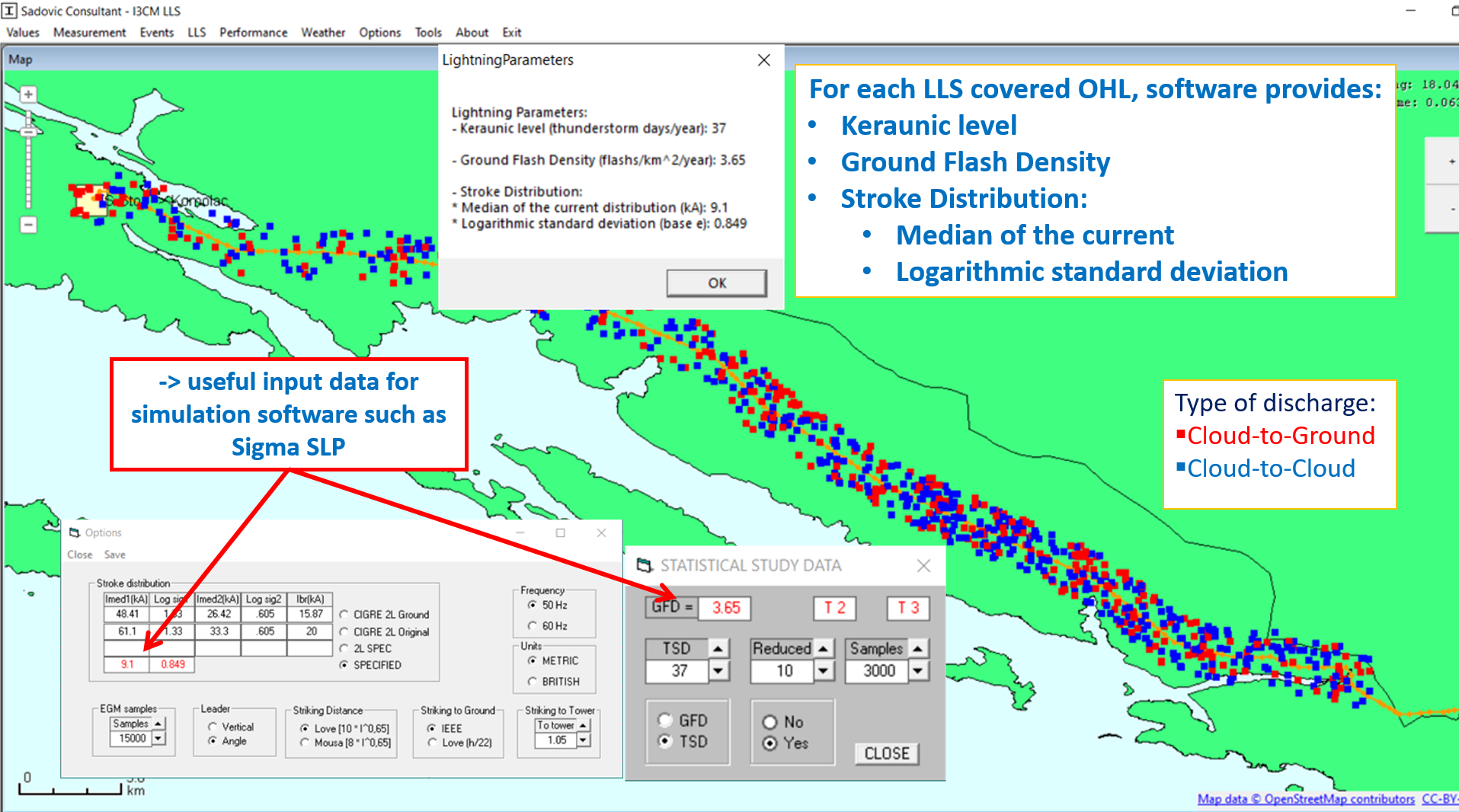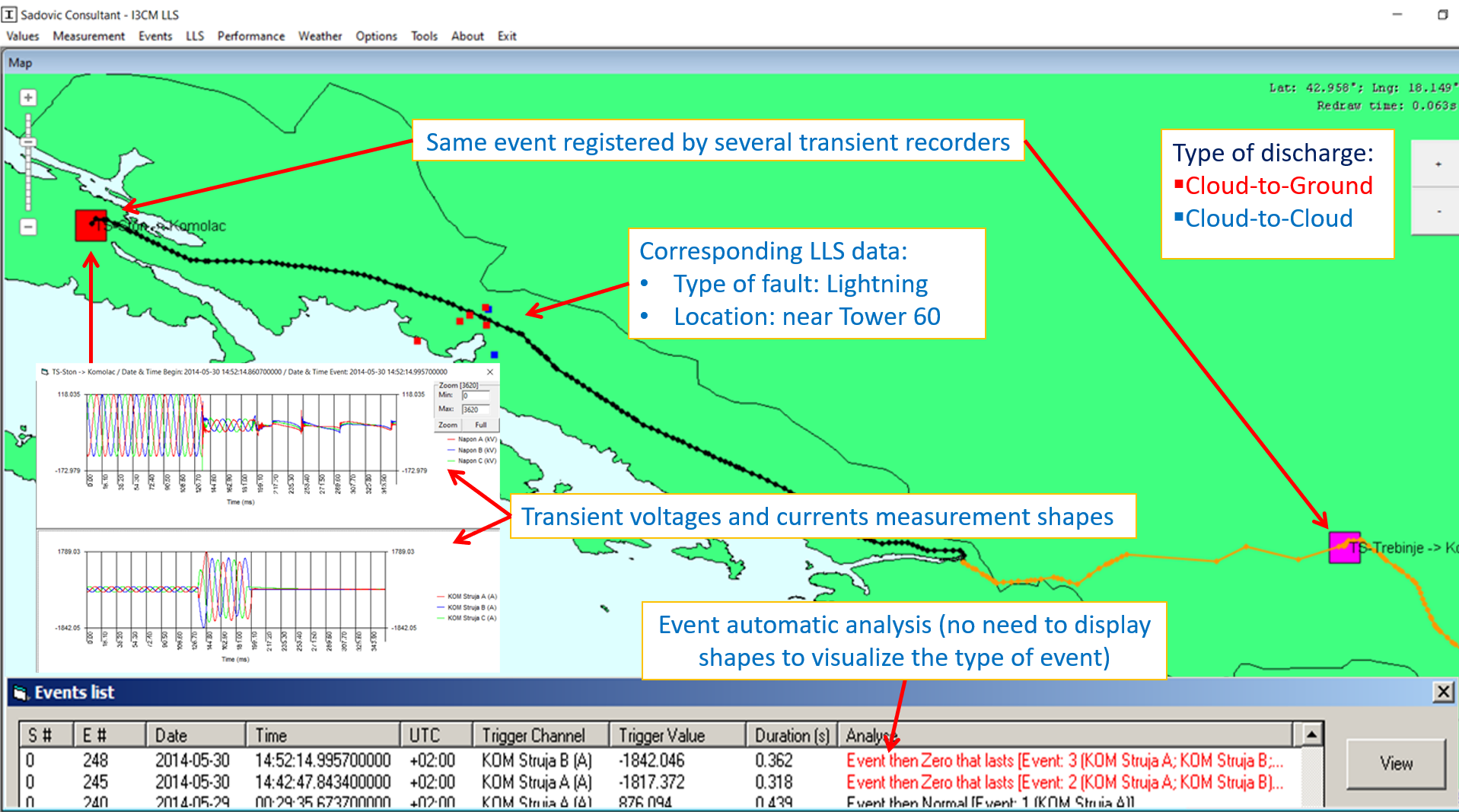
Image for illustrative purposes
EFFECTIVELY ADDRESSNG LIGHTNING PERFORMANCE AND CONTINUOUS MONITORING OF SYSTEM FAILURES

500kV Tower in South East Asia
For non-specialists, this double circuit lattice tower might seem conventional, but on closer inspection it is rather unique. Each phase conductor is protected by Line Surge Arresters (LSA).
LSA are used to prevent lightning induced flashovers. In this case, the system operator has adopted an EGLA technology (Externally Gapped Line Arrester). Although the choice of EGLAs is rather appropriate, especially on 500kV lines, some essential questions arise on such installations:
-
Is it optimal to protect every phase conductor? Couldn’t we find a better optimization?
-
How can I assess the condition of my LSA over time? How do I get the confidence they are still effective to protect my line?
-
Even better, can I get a confirmation they have done their duty of protection? And how many times?
Due Diligence as prerequisite
Many utilities and system operators are often confronted with difficulties in analyzing the lightning performance of their lines but especially in selecting effective and affordable methods to reduce outages.
Very often, the choice of LSAs comes as a last resort because they are considered (wrongly) as too expensive and not reliable enough.
But let us start from the beginning: utilities and system operators normally invest in LSA to reduce the lightning outages which are causing severe financial consequences:
-
Financial Damages
-
Penalties from clients
-
Costs of Momentary Outages
-
Grid instability / Continuity of Service
-
Intensive use of circuit breaker
The first challenge is to identify the critical line sections and start a due diligence process:
-
Identification of lightning induced outages vs. others outages
-
Investigation on Ground Flash Density (GFD) and Keraunic level
-
Verification of insulation coordination study
-
On-site measurement of tower footing resistance
-
Inspection of shield wires/OHGW
A decision matrix should help them evaluate the situation and prioritize a list of options to mitigate lightning outages with cost-effective solutions.
This process is NOT easy! Many biases come into play in the process because data are missing, information is wrong, or because long-held beliefs persist.
Utilities and system operators normally invest in LSA to reduce the lightning outages which are causing severe financial consequences.
Working with real-world data
Lightning detection techniques have been developing and improving in performance in recent years. Modern hardware/software solutions like I3CM LLS can help users record and analyze all lightning activities in the area of interest.
In the screenshot below, a typical 1km buffer has been chosen along the line of interest. Primary information is then extracted for further study:
-
Ground Flash Density or Keraunic Level
-
Cumulative Stroke Distribution
-
Median of the stroke amplitude
-
Logarithmic standard deviation

Screenshot I3CM LLS – Lightning parameters
Having taken care to carry out appropriate field inspections and measurements, it is appropriate to report the grounding conditions that are essential for effective system studies:
-
Soil resistivity
-
Towers Footing Resistances (TFR)
True Digitalization of the Monitoring
Monitoring is a “question” that often comes up, but it is also a concern that is often expressed by utilities and system operators. LSA is often seen as an asset that can fail and must be monitored. When properly designed, dimensioned, manufactured and installed, LSAs should not fail and their reported failures should remain low. When a failure occurs on one LSA, it does not jeopardize the system because other LSAs play their role along the line. Therefore, a preventive maintenance known as condition assessment, which could be costly and complex, should not be justified on LSA.
Nevertheless, monitoring solutions might be required to be effective in maintenance to be able to detect failure and plan the replacement.
Today there are proven technologies which can tackle the challenging process of line monitoring and failure detection:
-
Lightning Location System (LLS)
-
Double Ended Traveling Wave (TW)
-
Synchronization GNSS timestamp
-
Weather data analysis
-
Online-based software application with dedicated functions
I3CM LLS includes all those technologies. It is a comfortable real-time online monitoring tool intended to facilitate the identification, the categorization and the location of line faults. It goes much further than LSA failure detection. Here are some key features:
-
It helps utilities and system operators categorize faults and provide real-time notifications. It supports decisions and helps with prioritization.
-
Lightning outages can be detected and localized with high accuracy (~60 meters) and their types can be differentiated (Backflashover/Shielding failure). Weather data providers are queried if LLS data do not match.
-
Suspicious faults can be localized precisely and crews can be sent to the exact location for line inspection.
-
Digital twin of the line in I3CM LLS can be customized to provide specific features such as LSA failure detection.

Screenshot I3CM LLS – Fault detection with corresponding LLS data
Japan: an example to follow in terms of reliability
As per CRIEPI report from 2009, almost 365,900 units are installed in Japan. About 120,000 units are Current Limiting Gaps (CLG), which is a non-metal oxide technology. Therefore, we can estimate about 250,000 EGLA units in operation in Japan since the 1980’s.
Dedicated monitoring of EGLA units does not apply in Japan. Regular inspections are performed on transmission towers, insulators and therefore on EGLA in the meantime. Japanese utilities and system operators are able to localize a fault when a lightning induced outage is detected.
Over 20 years, the total number of overload/failures reported on a total of 365,900 units is 55 units! This is an extraordinary figure that should make you think about the EGLA technology and its reliability in improving the lightning performance on transmission lines compared to biases and misconception.

Overview of EGLA failures in Japan over 20 years operation
If we look at the modern EGLA type (compact) made of light-weight polymer housings and optimized ZnO blocks sizes, only 36 failures have been found for 160,000 units installed across the country for a period of 10 years.
Failure rate EGLA Compact = 0.0225 failure / 1000 units / year
In view of the statistical information on failures, there are countermeasures to easily reach low failures rates close to zero by adapting the charge transfer capability of SVU and improve the tightening system of the EGLA sets (better design/ extensive vibration tests).
Simulate and define your target
A simulation software like Sigma SLP can help the users to optimize their investment by running a computation of lightning performance.
Sigma SLP allows the modeling of your transmission line to analyze the effect of lightning strokes on its performance. Simulation can be made on systems without and with LSA. Sigma SLP includes a special feature to run those simulations on a complete line (various TFR and line spans) including an automatic LSA placement. It helps the users minimize their budget for a maximum improvement.
The customized stroke distribution model can be used based on real-world data instead of using conservative (and often excessive) CIGRE models which vary depending on the countries.

Screenshot Sigma SLP – Composite Performance and automatic LSA placement
Sigma SLP has been first commercialized in the early 2000’s. It results from different research works by Prof. Dr. Salih Sadovic in collaboration with international experts.
The software continues to be supported by Sadovic Consultant. The latest update of Sigma SLP is version 3.1 (2022) that includes the possibility to define the failure rate probability based on specific stroke distribution models.
Users can then easily define their budget (number of LSA) to reach a specific target (performance – outages / 100km / year). Experience often shows that a study of this type can achieve very significant levels of improvement without the need to completely equip a line with LSA. This is a thorough and scientific approach.
The example below shows the following results for a 170kV shielded double circuit line:
-
2% improvement (outages reduction) by protecting only 4 phases
-
1% improvement (outages reduction) by protection only 3 phases and results in 100% improvement for double circuit outages.

Sigma SLP composite performance study on 170kV system in Turkey – INMR 2022, ADM
Over 20 years, the total number of overload/failures reported in Japan on a total of 365,900 units is 55 units! This is an extraordinary figure that should make you think about the EGLA technology and its reliability in improving the lightning performance on transmission lines compared to biases and misconception.
Conclusion
LSA is still an underrated method for effective lightning performance improvement.
Biases and misconceptions prevent putting LSA in the spotlight.
EGLA experience feedback shows extremely high reliability.
Modern monitoring solutions can help system operators to simulate lightning performance with real word data.
Simulations tools, such as Sigma SLP, can be very effective to optimize investments.
The behavior of lightning is predictable. And so must be the expected performance improvement.
The performance remains stable over time, as opposed to other methods, such as improving grounding conditions.
Individual LSA monitoring is not justified economically and remains complex today.
Dedicated real-time monitoring solutions, such as I3CM LLS, have been developed to offer comfortable LSA failure detection among others features, such as fault localization and categorization.












